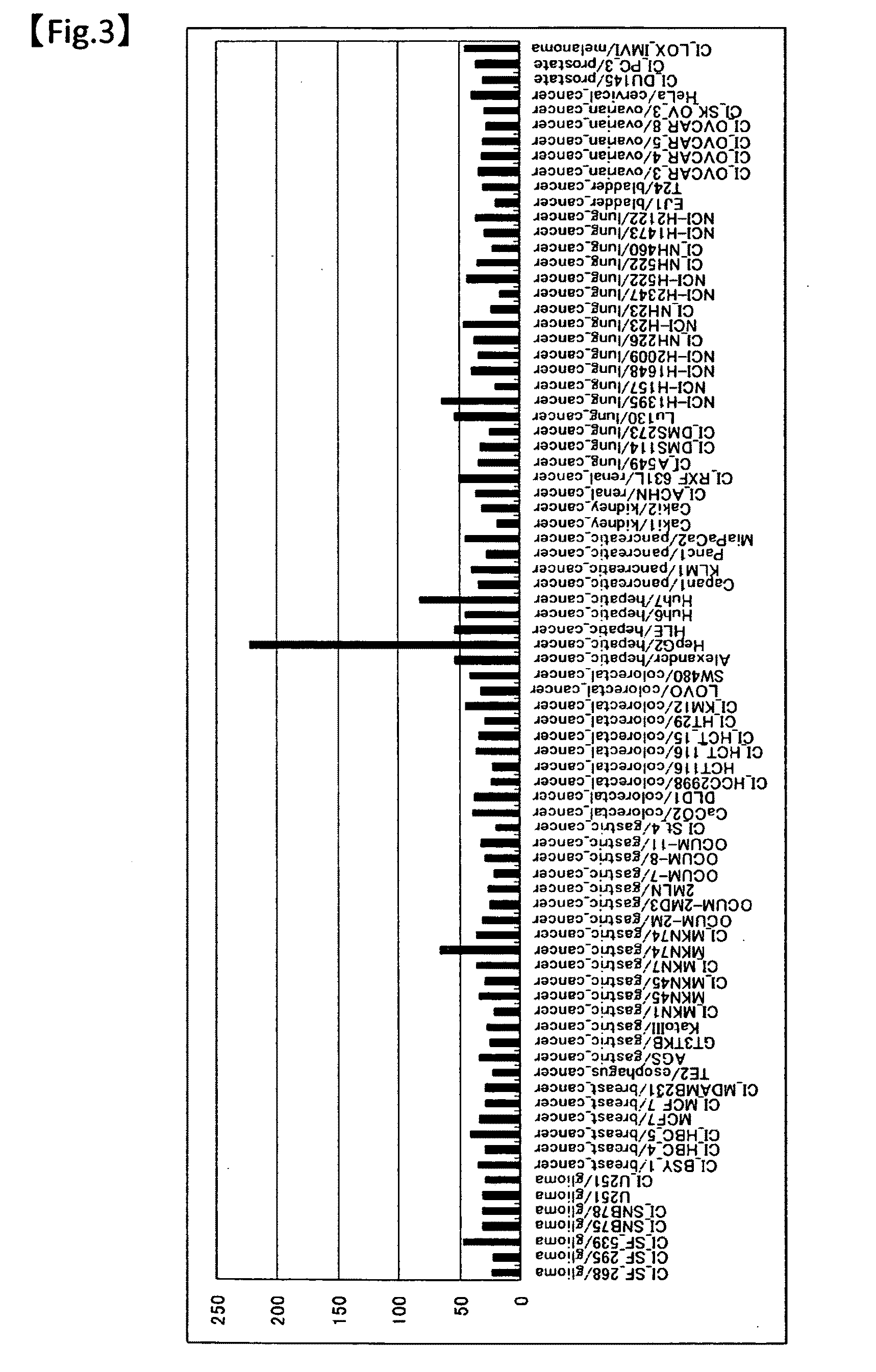Diagnosis and treatment of cancer by using Anti-prg-3 antibody
a technology of anti-prg-3 and cancer, which is applied in the field of cancer diagnosis and treatment, can solve the problems of inability to use molecular targeted drugs for hcc, inability to analyze the role of other types of cancer, and difficulty in detecting cancer. the effect of prg-3
- Summary
- Abstract
- Description
- Claims
- Application Information
AI Technical Summary
Benefits of technology
Problems solved by technology
Method used
Image
Examples
example 1
Analysis of Human PRG-3 Gene Expression in Various Cancers
1-1. Analysis of Human PRG-3 Gene Expression Using a GeneChip
[0335]To specifically search for genes with enhanced expression in liver cancer tissue, a comprehensive analysis of gene expression in normal tissue, cancer tissue, and cancer cell lines was performed using a GeneChip U-133A (Affymetrix).
[0336]Initially total RNA was prepared from the normal tissue, cancer tissue, and cancer cell lines shown in Tables 1, 2, and 3 in a conventional manner using ISOGEN (Nippon Gene). Then gene expression analysis was performed using 10 μg of each total RNA with a GeneChip U-133A (Affymetrix) in accordance with the Expression Analysis Technical Manual (Affymetrix). The mean value of the expression score of all genes was set at 100, and a search for the genes with enhanced expression in cancer tissue or cancer cells was carried out.
TABLE 1Tissues analyzed for the expression of PRG-3 geneSampleOriginWhole_BrainClontech 64020-1Brain_Amygd...
example 2
Preparation of Anti-PRG-3 Monoclonal Antibody
2-1. Establishment of Cell Line Expressing Whole Human PRG-3
[0338]Whole human PRG-3 cDNA (polynucleotide sequence SEQ ID NO: 59 and amino acid sequence SEQ ID NO: 60) was isolated by PCR using the sequence NCBI Accession No. AK000307: Homo sapiens cDNA FLJ20300 fis, clone HEP06465 as a basis, and it was cloned to a mammalian cell expression vector (pcDNA5 / FRT / TO, Invitrogen). The vector pcDNA5 / FRT / TO enables inducible expression of a transferred gene under the hybrid human CMV / Tet02 promoter, and it is a vector containing a neomycin resistance gene as a drug resistance marker. Additionally, using the FlpIn expression system (Invitrogen), which enables inducible expression only in the presence of tetracycline or doxycycline, the whole human PRG-3 cDNA gene was transferred into 293FlpIn T-Rex cells. Fugene6 (Roche) was used for transfer of the expression vector into the 293FlpIn T-Rex cells cultured with DMEM (high glucose) / 10% FBS / 100 μg / m...
example 3
Measurement of Complement-Dependent Cytotoxicity (CDC) Activity and Antibody-Dependent Cell-Mediated Cytotoxicity (ADCC) Activity of Anti-PRG-3 Monoclonal Antibodies
3-1. Measurement of CDC Activity of the Anti-PRG-3 Monoclonal Antibodies
[0345]The CDC activity was measured using the extent of uptake of 7-AAD by cells wherein cytotoxicity had occurred as an indicator.
[0346]A Ba / F3 cell transformant line was established by gene transfer of the pMCN-PRG-3 expression vector constructed in example 2 into Ba / F3 cells, which is a murine pro B cell line, by electroporation under conditions of 0.33 kV and 950 μF. The Ba / F3 cells are IL-3 dependent cells, and they were cultured in RPMI-1640 / 10% FBS / penicillin-streptomycin containing 1 ng / mL IL-3. The cells that underwent gene transfer were selected by RPMI-1640 / 10% FBS / penicillin-streptomycin containing IL-3 and 500 μg / mL Geneticin® (Invitrogen). Cells expressing PRG-3 from the Geneticin®-resistant lines were selected by flow cytometry. Becaus...
PUM
| Property | Measurement | Unit |
|---|---|---|
| Kinematic viscosity | aaaaa | aaaaa |
| Cytotoxicity | aaaaa | aaaaa |
| Chemotherapeutic properties | aaaaa | aaaaa |
Abstract
Description
Claims
Application Information
 Login to View More
Login to View More - R&D
- Intellectual Property
- Life Sciences
- Materials
- Tech Scout
- Unparalleled Data Quality
- Higher Quality Content
- 60% Fewer Hallucinations
Browse by: Latest US Patents, China's latest patents, Technical Efficacy Thesaurus, Application Domain, Technology Topic, Popular Technical Reports.
© 2025 PatSnap. All rights reserved.Legal|Privacy policy|Modern Slavery Act Transparency Statement|Sitemap|About US| Contact US: help@patsnap.com



